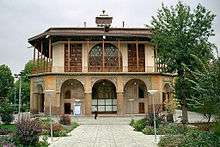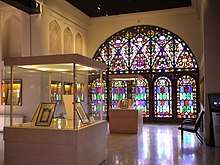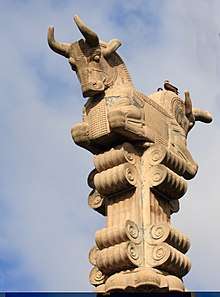Qazvin
Qazvin (/kæzˈviːn/; Persian: قزوین, IPA: [ɢæzˈviːn] (![]()
Qazvin قزوین Caspian, Minoodar, Razhia, Arsas | |
|---|---|
City | |
 Caravanserai of Sa'd al-Saltaneh | |
 Seal | |
| Motto(s): Mirror of History & Natural of Iran | |
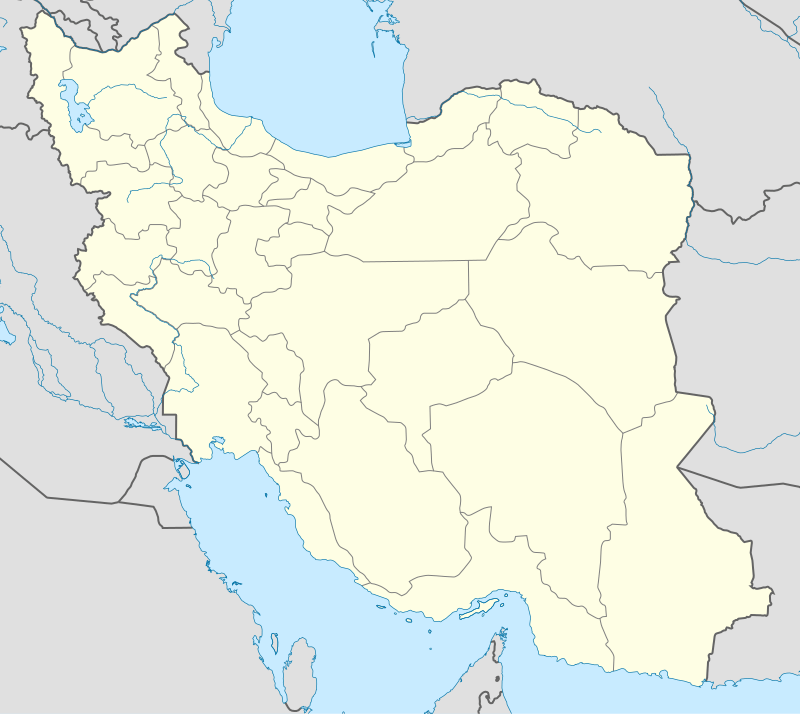 Qazvin | |
| Coordinates: 36°16′N 50°00′E | |
| Country | |
| Province | Qazvin |
| County | Qazvin |
| Bakhsh | Central |
| Government | |
| • Type | Mayor-Council |
| • Mayor | Siavash Taherkhani |
| Area | |
| • City | 64.132 km2 (24.762 sq mi) |
| Elevation | 1,278 m (4,193 ft) |
| Population (2016 census) | |
| • Density | 9,030/km2 (23,400/sq mi) |
| • Urban | 402,748[1] |
| Time zone | UTC+3:30 (IRST) |
| • Summer (DST) | UTC+4:30 (IDST) |
| Area code(s) | 028 |
| Climate | BSk |
| Website | www |
Located in 150 km (93 mi) northwest of Tehran, in the Qazvin Province, it is at an altitude of about 1,800 m (5,900 ft) above sea level. The climate is cold but dry, due to its position south of the rugged Alborz range called KTS Atabakiya.
History
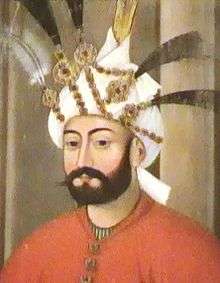
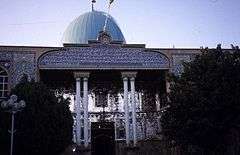
The city was a capital of the Persian Empire under Safavids in 1548–1598.[3] It is a provincial capital today that has been an important cultural center throughout history.
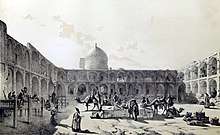
Archeological findings in the Qazvin plain reveal urban agricultural settlements for at least nine millennia. Qazvin geographically connects Tehran, Isfahan, and the Persian Gulf to the Caspian seacoast and Asia Minor, hence its strategic location throughout the ages.
The city today known as Qazvin is thought to have been founded by Shapur II, King of Persia in 250 CE, under the name Shad Shahpur (shad can be read as 'happy'), when he built a fortification there to control regional tensions.
Qazvin has sometimes been of central importance at major moments of Iranian history. It was captured by invading Arabs (644 AD) and destroyed by Hulagu Khan (13th century). After the Ottoman capture of Tabriz, Shah Tahmasp (1524–1576) made Qazvin the capital of the Safavid empire (founded in 1501 AD), a status that Qazvin retained for half a century until Shah Abbas I moved the capital to Isfahan.[3]
In 1210 the city was damaged by the forces of Kingdom of Georgia sent by Tamar the Great, as per the retribution for destroying Georgian-controlled Ani by the Muslim forces that left 12,000 Christians dead.[4][5]
In the 19th century Qazin flourished as a center of trade because the only all-year accessible road from the Caspian Sea to the Highland started here and with enhanced traffic on the Caspian Sea the trade volume grew. Its bazaars were enlarged.[6] In the middle of the century the Babi movement had one of its centers here and the first massacre of Babis occurred in Qazvin in 1847.[7]
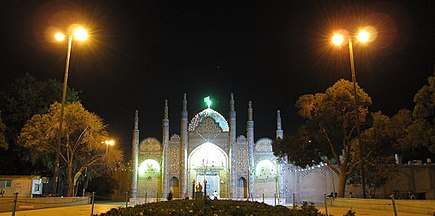
In the second half of the 19th century Qazvin was one of the centers of Russian presence in northern Iran. A detachment of the Persian Cossack Brigade under Russian officers was stationed here. From 1893 this was the headquarters of the Russian Company for Road construction in Persia which connected Qazvin by roads to Tehran and Hamadan. The company built a hospital and the St. Nicolas Church.
In 1920 Qazvin was used as a base for the British Norperforce.[8] The 1921 Persian coup d'état that led to the rise of the Pahlavi dynasty was launched from Qazvin.
Qazvin has been one of the main pivots on which Persia's history has revolved and this is where its reputation as an impenetrable fortress originates. During the fall of the Safavids, Qazvin was the centre of Persians reunion for the liberation of Persian territories invaded by Ottoman, Russian, and Afghan forces in the west, north, and east, respectively. The deployed swordsmen from Qazvin not only retrieved Safavid boundaries, but also contributed to their expansion up to China (east), Nader Shah The Great, Daghestan (north) and Baghdad (west). Similarly, Qazvin hosted the base of Assassins and was the training centre of the Nehzat-e Jangal (The Jungle Movement) revolutionaries.
Qazvin became a state in 1996. In Autumn 2015 portions of Qazvin were struck by a meteorite.[9]
People
The majority of the people of the city of Qazvin are Persians. The majority language is Persian with a Qazvini accent.[10] Azerbaijanis and Tats are the other ethnic groups of the city of Qazvin.[11] They speak Azerbaijani and Tati.[12]
Climate
Qazvin has a hot-summer Mediterranean climate (Köppen climate classification Csa).
| Climate data for Qazvin | |||||||||||||
|---|---|---|---|---|---|---|---|---|---|---|---|---|---|
| Month | Jan | Feb | Mar | Apr | May | Jun | Jul | Aug | Sep | Oct | Nov | Dec | Year |
| Average high °C (°F) | 5.1 (41.2) |
7.6 (45.7) |
13.7 (56.7) |
20.0 (68.0) |
25.9 (78.6) |
32.2 (90.0) |
35.6 (96.1) |
34.6 (94.3) |
30.9 (87.6) |
23.1 (73.6) |
15.4 (59.7) |
8.1 (46.6) |
21.0 (69.8) |
| Daily mean °C (°F) | 0.2 (32.4) |
2.4 (36.3) |
7.7 (45.9) |
13.2 (55.8) |
18.3 (64.9) |
23.4 (74.1) |
26.7 (80.1) |
25.8 (78.4) |
21.9 (71.4) |
15.5 (59.9) |
9.2 (48.6) |
3.1 (37.6) |
13.9 (57.1) |
| Average low °C (°F) | −4.7 (23.5) |
−2.9 (26.8) |
1.7 (35.1) |
6.4 (43.5) |
10.6 (51.1) |
14.6 (58.3) |
17.7 (63.9) |
16.9 (62.4) |
12.9 (55.2) |
7.8 (46.0) |
2.9 (37.2) |
−1.9 (28.6) |
6.8 (44.3) |
| Average precipitation mm (inches) | 44.5 (1.75) |
40.8 (1.61) |
52.1 (2.05) |
41.0 (1.61) |
34.5 (1.36) |
5.9 (0.23) |
1.2 (0.05) |
1.9 (0.07) |
0.8 (0.03) |
21.7 (0.85) |
27.8 (1.09) |
44.0 (1.73) |
316.2 (12.43) |
| Average precipitation days | 10.5 | 10.1 | 13.3 | 13.3 | 12.7 | 4.5 | 2.4 | 2.3 | 2.0 | 7.7 | 7.9 | 9.7 | 96.4 |
| Source: World Meteorological Organisation | |||||||||||||
Main sights
Qazvin contains several archeological excavations. In the middle of the city lie the ruins of Meimoon Ghal'eh, one of several Sassanid edifices in the area.
Qazvin contains several buildings from the Safavid era, dating to the period in which it was capital of Persia. A well known of the surviving edifices is the Chehel sotoun, Qazvin,[13] today a museum in central Qazvin.

After Islam, the popularity of mystics (tasawwuf), as well as the prominence of tradition (Hadith), religious jurisprudence (fiqh), and philosophy in Qazvin, led to the emergence of many mosques and religious schools. They include:
- Jame' Atiq Mosque of Qazvin
- Heydarieh Mosque
- Masjed Al-Nabi (Soltani Mosque): With an area of 14000 m2, this mosque is one of the most glorious mosques of antiquity, built in the Safavieh's monarchy era.
- Sanjideh Mosque: Another mosque of Qazvin dating back to pre-Islamic Iran; a former fire temple. Its present-day form is attributed to the Seljukian era.
- Panjeh Ali Mosque: A former place of worship for royal harem members in the Safavid period.
- Peighambarieh School-Mosque: Founded 1644 according to inscription.
- Peighambarieh Shrine: Where four Jewish saints who foretold the coming of Christ, are buried.[14][15][16]
- Molla Verdikhani School-Mosque: Founded in 1648.
- Salehieh Madrasa and Mosque: Founded in 1817 by Mulla Muhammad Salih Baraghani.
- Sheikhol Islam School-Mosque: Renovated in 1903.
- Eltefatieh School: Dating back to the Il-Khanid period.
- Sardar School- Mosque: Made by two brothers Hossein Khan and Hassan Khan Sardar in 1815, as a fulfillment of their promise if they came back victorious from a battle against the Russians.
- Shazdeh Hosein Shrine; a c.15C CE shrine to a c.9C CE Shiite saint.
- Aminiha Hosseiniyeh
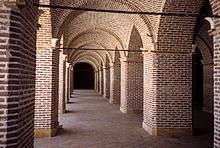

About 100 km (62 mi) south-west of Qazvin are the tombs of two Saljuki era princes — Abu Saeed Bijar, son of Sa'd, and Abu Mansur Iltai, son of Takin — located in two separate towers known as the Kharraqan twin towers. Constructed in 1067 CE, these were the first monuments in Islamic architecture to include a non-conic two-layered dome. Both towers were severely damaged by a devastating earthquake in March 2003.
Sepah Street (خیابان سپه , pronounced "Cepah" referring to ancient Persian army and not the revolutionary guards pronounced "Sipaahe") is known as the first modern street in Iran. This street entirely is carpeted with carved gray stone and is surrounded by craftsmen gift shops (used to be bars or bygone liquorshops, called May'kadeh) and hosts historical places such as Qazvin's Ali Qapu gate, entrance of Jame' Atiq mosque and historical schools.
Qazvin has three buildings built by Russians in the late 19th/early 20th century. Among these is the current Mayor's office (former Ballet Hall) and a water reservoir. St. Nicholas church was built in 1904 by the Russian Company for Roads in Persia which had its headquarter here. The church was in use until being decommissioned in 1984 because the community of Russian emigres in Qazvin did not exist any more. The iconostasis and bell was removed to Tehran and the building handed over to the Iranian government which keeps it available to the public as a historic monument. In front of the church is a 1906 memorial to a Russian road engineer.[17]
Economy
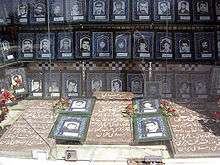
Qazvin today is a center of textile trade, including cotton, silk and velvet, in addition to leather. It is on the railroad line and the highway between Tehran and Tabriz. Qazvin has one of the largest power plants feeding electricity into Iran's national power grid, the Shahid Raja'i facility, which provides 7% of Iran's electrical power.
Colleges and universities
Qazvin has several institutes of higher education:
- Imam Khomeini International University
- Islamic Azad University of Qazvin[18]
- Payam-e-Nur University of Qazvin
- Qazvin University of Medical Sciences
- Raja University[19]
- Shahid Babaee Technical Institute[20]
- Kar University[21]
- Parsian Higher Education Institute
- Dehkhoda University[22]
- Ghazali University[23]
- Mir-Emad Higher Education Institute
- Darolfonoun University
- Allameh Ghazvini University[24]
Modern towers
Some famous residential towers are: Punak (536 units), Aseman, Elahieh, Bademestan (440 units in 17 floors) and Tejarat tower with 28 floors.
Shopping complexes
- City Star in Khayam Street
- Ferdowsi in Ferdowsi Street
- Iranian in Adl Street
- Narvan in Ferdowsi Street
- Noor in Felestin Street
- Meh ro mah Bouali Street
- Alghadir on South Khayam Street
- Alavi on Taleghani Street
Bridges
- Naderi
- Molasadra
- Ertebatat
- Persian Gulf (Khalij Fars)
- Abotorabi
- Nasr
- Motahari
- Imam Ali
- Rajaei
Famous hotels
- Alborz
- Safir
- Mir Emad
- Iranian
- behrouzi historical house
- Iran
- Marmar
- Razhia
- Ghods(closed)
- Grand Hotel, Qazvin
- Noizar
- Minno
- Sina (new)
Major parks
- Shohada
- Dehkhoda
- Beheshti
- Fadak (Barajin)
- Mellat
- Al-Ghadir
- Afarinesh
- Molla Khalila
Hypermarkets
- Proma Hypermarket (closed) HyperKeeper is new Brand .
- Refah Chain Stores Co
- Kourosh chain stores in several city blocks
- Janbo chain stores
- Ferdowsi supermarket in Adl sq.
- Haft (7) Chain stores
- Talaei’yeh Minoudar Supermarket
- noor shopping mall hyper market * easy to access near city center
Transportation
- Qazvin railway station.
- Qazvin Airport.
- Qazvin Eastern Bus terminal
- Qazvin southwestern terminal (Takestan & Hamedan)
Sport
Qazvin is a well-known city because of its famous athletes. The city has highly focused on athletic teams along recent years. Techmash is a basketball team which entered Iranian Basketball Super League in 2013.
Notable Qazvinis
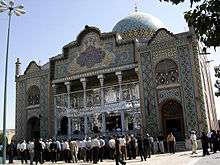
There have been an abundance of known people who lived in Qazvin, or came from Qazvin, whose tombs are scattered throughout the cities and villages of the province. These include:
Pre-Modern time
- Ibn Majah, author of the last of the six canonical hadith collections recognized by Sunni Muslims.
- Hamdollah Mostowfi: the great Il-Khanid historian and writer.
- Ubayd Zakani: famous 8th-century poet noted for his satire and obscene verses.
- Mir Emad Hassani: famous Nasta'liq calligrapher
- Darvish Ablulmajid: famous Shekaste Nasta'liq calligrapher
- Mirza Mohammed Reza Qazvini: Persian envoy of Franco-Persian alliance
Modern time
- Yousef Alikhani: contemporary fiction writer and researcher.
- Azizi family: a well-known family that originates from Qazvin includes |Sheikh Ahmad Azizi] who is buried in Peighambariyeh shrine, known research and medical doctor Dr. Sadegh Pirooz Azizi, the former Minister of Foreign Affairs from 1997–2005 Mr. Ahmad Azizi, hadi Azizi and Abolghasem Azizi.
- Ali Akbar Dehkhoda: prominent linguist and author of Iran's first modern Persian dictionary.
- Abdul Hossein Darki: known doctor.
- Jamal Karimi-Rad: former Minister of Justice (2005–2006).
- Hadi Mirmiran: architect.
- Shirin Neshat: Famous contemporary Iranian artist.
- Mojabi family: a prominent family that originates from Qazvin including Javad Mojabi and Zohreh Mojabi.
- Molla Khalil Ibn Ghazi Qazvini: famous faqih (religious jurist) and commentator of the Qur'an in the Safavid period (d. 1678).
- Aref Qazvini: poet, lyricist, and musician.
- Ra'ees ol-Mojahedin: The late Mirza Hassan Sheikh al-Islam, son of Mirza Masoud Sheikh al-Islam, leader of the liberals and constitutionalists of Qazvin.
- Shahid Saless: killed in 1846. The third religious leader after Imam Ali who was murdered during prayer.
- Kázim-i-Samandar: a famous follower of Bahaullah.
- Monir Shahroudy Farmanfarmaian: Famous contemporary Iranian artist.
- Táhirih: influential poet and theologian of the Bábí Faith.
- Nasser Takmil Homayoun: a contemporary historian.
- Nasser Yeganeh: Chief Justice of the Supreme Court (1975–79).
- Haj seyed Javadi: politician in early 1980s.
- Abbas Babaei: Brigadier General in the Islamic Republic of Iran Air Force
Notable people buried in Qazvin
- Uwais Qarni: a celebrity of early Islam, thought to have been killed here while fighting against an army of Deilamian origin.
- Ahmad Ghazali: famous Iranian sufi who died in 1126 CE and was buried beside Shahzadeh Hossein.
- Ali Ibn Shazan: great scholar of the fifth century.
- Shahzadeh Hossein: Shiite saint.
- Abbas Babaei
Twin towns – sister cities

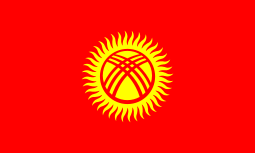




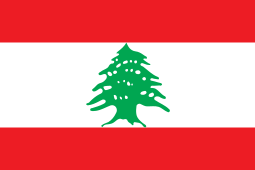




See also

- Caspians
- List of famous ab anbars of Qazvin
- Qazwini (disambiguation), a personal name meaning "from Qazwin"
References
- https://www.amar.org.ir/english
- Qazvin / قزوين (Iran): Province & Cities – Population Statistics in Maps and Charts
- Iran (5th ed., 2008), by Andrew Burke and Mark Elliott, p. 28 Archived June 7, 2011, at the Wayback Machine, Lonely Planet Publications, ISBN 978-1-74104-293-1
- Mikaberidze, Alexander (2011). Conflict and Conquest in the Islamic World: A Historical Encyclopedia, Volume 1. Santa Barbara, California, USA: ABC-CLIO. p. 196. ISBN 978-1598843361.
- L. Baker, Patricia; Smith, Hilary; Oleynik, Maria (2014). Iran. London, United Kingdom: Bradt Travel Guides. p. 158. ISBN 978-1841624020.
- "Qazvin" in Historic Cities of the Islamic World, p. 435
- Baha'i History of Qazvin
- Haldane, J. Aylmer L. Sir (2005), The insurrection in Mesopotamia, 1920, London: The Imperial War Museum in association with The Battery Press, ISBN 1904897169, OCLC 60688896, OL 22727753M, 1904897169
- Large meteorite impacts Iran causing serious damage to Qazvin, numerous towns affected
- The official Media from Qazvin- February 10-2010 Archived November 2, 2013, at the Wayback Machine
- Tats of Iran and Caucasus, Ali Abdoli, 2010.
- Qazvin
- "Architecture of water supply to Chehel Sotoun studied". ISNA. 2018-06-17. Retrieved 2020-03-14.
- "Arash Nooraghayee". Archived from the original on 2010-02-13. Retrieved 2010-02-02.
- iranian.com: Nima Kasraie, Qazvin water reservoirs
- Peighambarieh Mausoleum in Qazvin: Burial place of Israeli prophets
- РУССКАЯ ПРАВОСЛАВНАЯ ЦЕРКОВЬ В ПЕРСИИ – ИРАНЕ (1597–2001 гг.) Игумен Александр (Заркешев) Санкт-Петербург 2002 – Russian Orthodox Church in Persia-Iran 1597–2001, by abbot Alexander Zarkeshev, St Peterburg 2002, pp 70f and 110 Archived December 10, 2014, at the Wayback Machine; the church is sometimes referred to as "Kantur" church from the name of the area where it stands
- qiau.ac.ir
- "Raja University". Archived from the original on 2017-10-06. Retrieved 2020-05-13.
- afshbq.ac.ir Archived December 12, 2004, at the Wayback Machine
- kar.ac.ir
- adi.ac.ir
- ghazali.ac.ir
- allamehghazvini.ac.ir
External links
| Wikivoyage has a travel guide for Qazvin. |
| Wikimedia Commons has media related to Qazvin. |
- Satellite Picture by Google Maps
- FallingRain Map – elevation = 1285 m (Red dots are railways)
- towers profile
- How to go to Qazvin from Tehran? (Bus, Taxi or Train)
| Preceded by Tabriz |
Capital of Iran (Persia) 1555–1598 |
Succeeded by Isfahan |
| Preceded by Tabriz |
Capital of Safavid dynasty 1555–1598 |
Succeeded by Isfahan |
